Understanding PTSD
Post-traumatic stress disorder (PTSD) is a mental health condition caused by experiencing or witnessing an extremely traumatic event. It’s natural to feel afraid and stressed after trauma, but PTSD develops when these stress reactions persist for a long time and disrupt daily life. People with PTSD often have intense, disturbing thoughts and feelings related to their trauma long after the event has ended. In fact, PTSD is fairly common – about 6 out of every 100 people will experience PTSD at some point in their lives. The condition can affect anyone, from combat veterans and assault survivors to people who lived through accidents or disasters. The good news is that PTSD is treatable, and many people recover with proper care.
Symptoms of PTSD
PTSD symptoms usually begin within a few months of the traumatic event, but they can sometimes surface years later. These symptoms last more than one month and interfere with daily functioning. PTSD symptoms are often grouped into four categories:
Intrusive memories: Unwanted distressing memories, flashbacks (reliving the trauma as if it’s happening again), or nightmares related to the event. Reminders of the trauma (for example, a loud noise similar to gunfire) can trigger intense emotional or physical reactions.
Avoidance: Deliberately avoiding thoughts, feelings, people, places, or activities that remind one of the traumatic event. A person might refuse to talk about what happened or stay away from anything associated with the trauma.
Negative changes in mood and thinking: Ongoing feelings of fear, guilt, or shame; negative thoughts about oneself or the world; feeling detached from friends and family; losing interest in activities once enjoyed. Many with PTSD have trouble feeling positive emotions and may feel emotionally numb. Depression or hopelessness can accompany these mood changes.
Arousal and reactivity changes: Being “on edge” or easily startled, having angry outbursts or irritability, sleep problems, difficulty concentrating, or engaging in self-destructive behavior (like reckless driving or substance abuse). The body’s fight-or-flight response is in overdrive, so people with PTSD may feel constantly alert for danger, known as hyperarousal.
These symptoms can come and go. They might flare up during times of stress or when you encounter reminders of the trauma (for example, an anniversary of the event). It’s also common for people with PTSD to have physical symptoms like headaches or stomach aches and to experience other problems such as anxiety, depression, or substance use issues. If you or someone you know has thoughts of self-harm or suicide in the context of PTSD, it’s critical to seek help immediately (for instance, by calling the 988 Suicide & Crisis Lifeline in the U.S.).
Causes and Risk Factors
Cause (Trauma): PTSD is triggered by going through or seeing a terrifying ordeal involving the threat of death, serious injury, or violence. This could be combat exposure, a serious accident, a natural disaster, sexual assault, or other life-threatening events. Not everyone who experiences trauma develops PTSD – in fact, most people recover with time. However, for reasons not fully understood, some individuals’ stress response remains stuck in “high alert,” leading to PTSD.
Risk factors that make someone more likely to develop PTSD include:
Experiencing severe or long-lasting trauma, or multiple traumas over time (such as repeated abuse).
Getting physically hurt during the event.
A history of earlier life trauma, like childhood abuse.
High-stress occupations that expose people to trauma (soldiers, first responders).
Mental health history: Existing issues like anxiety or depression, or a family history of these conditions.
Lacking a strong support system of family and friends after the event.
Substance misuse (heavy drinking or drug use) which can worsen coping abilities.
Gender: Women tend to be more likely than men to develop PTSD, according to research. Hormonal factors or higher rates of certain types of trauma may contribute to this difference.
It’s important to remember that PTSD is not a sign of weakness. Surviving a traumatic event affects people in different ways. Biological factors (like how one’s brain and nervous system respond to stress) and personal temperament also play a role. For example, an overactive amygdala (the brain’s fear center) or inherited traits could increase the risk. If trauma occurs in a context of little support or if additional hardships follow, PTSD becomes more likely. On the other hand, factors like seeking support from loved ones or counselors after trauma can foster resilience and may protect against PTSD.
Treatment and Recovery
Early intervention is valuable – reaching out for help soon after PTSD symptoms start can prevent them from worsening. PTSD is primarily treated with a combination of psychotherapy (talk therapy) and medication, and treatment can significantly improve quality of life. Many people find they are able to gain control over their symptoms and feel better over time with proper care.
Therapy: The main treatment for PTSD is psychotherapy. One effective approach is cognitive behavioral therapy (CBT), especially a form called trauma-focused CBT. This therapy helps individuals process the traumatic event and change negative thought patterns. For example, cognitive therapy can help someone challenge unhelpful beliefs (like self-blame for the trauma) and develop healthier ways of thinking about the event. A specific technique, exposure therapy, gradually and safely exposes individuals to trauma memories or reminders (sometimes using virtual reality for realistic simulations) so they can work through fear and learn coping skills. Over time, this can reduce flashbacks and anxiety responses by teaching the brain that reminders of the trauma are not dangerous. Another therapy used for PTSD is EMDR (Eye Movement Desensitization and Reprocessing), which involves processing distressing memories while focusing on external stimuli (often eye movements); EMDR has been shown to help some people heal from trauma. Therapy can be one-on-one or in groups – support groups or group therapy with others who have PTSD can provide a sense of connection and understanding.
Medications: Certain medications can help relieve PTSD symptoms, often used in combination with therapy. The most common are antidepressants, particularly SSRIs (selective serotonin reuptake inhibitors) such as sertraline (Zoloft) and paroxetine (Paxil), which are FDA-approved for PTSD. These can help with sadness, anxiety, and sleep problems. Another class, SNRIs like venlafaxine (Effexor XR), is also used for PTSD. It’s important to note that medications typically take a few weeks to start improving symptoms. Anti-anxiety medications (like benzodiazepines) might be prescribed short-term for acute anxiety or insomnia, but they are not a first-choice long-term solution due to risks like dependence. In some cases, a blood pressure medication called prazosin has been used off-label to reduce nightmares or night sweats in PTSD. Some studies found prazosin can help with sleep-related symptoms, though research results have been mixed on its effectiveness. The best medication plan is individualized – a healthcare provider will work closely to find what works while managing side effects.
New and emerging treatments: Research into PTSD is ongoing, and new approaches are being explored. For example, a procedure called the stellate ganglion block – an injection of anesthetic near a bundle of nerves in the neck – has shown promise in clinical studies for reducing PTSD symptoms, though it’s not yet FDA-approved specifically for PTSD. There is also research interest in novel therapies such as MDMA-assisted therapy (using a medication commonly known as ecstasy in controlled clinical settings) and ketamine for severe cases of PTSD. As of 2025, these experimental therapies are not part of standard treatment, but early trials suggest they may offer benefit for some individuals who haven’t responded to traditional treatments. Always seek treatments through licensed professionals – if a new therapy becomes available, a specialist in PTSD can advise whether it’s appropriate.
Self-care and coping: In addition to professional treatment, lifestyle and self-care strategies play a role in PTSD recovery. Maintaining routines, getting regular exercise, practicing relaxation techniques (like deep breathing or mindfulness meditation), and staying connected with supportive friends or family can all help manage symptoms. It’s crucial to avoid unhealthy coping such as misusing alcohol or drugs – while it might be tempting to numb the pain, substance use will worsen PTSD in the long run. Instead, building healthy habits (good sleep, balanced diet, avoiding excess caffeine/nicotine which can heighten anxiety) supports your overall recovery. Many people with PTSD find that over time, with treatment and support, their symptoms diminish or become more manageable. Most people do recover or at least see significant improvement in their ability to function and enjoy life. Healing doesn’t mean forgetting what happened; rather, it means learning ways to cope so that the trauma doesn’t control your life.
Seeking Help
If you have symptoms of PTSD – for example, months after a trauma you still feel on-edge, are plagued by nightmares, or avoid much of life to escape memories – reach out to a healthcare provider or mental health professional. PTSD is not something one should “just get over” or handle alone. Treatment can be very effective, but the first step is getting a proper diagnosis and connecting with help. A doctor or therapist can evaluate your symptoms and history (often through conversations and questionnaires). They will check that the symptoms are indeed PTSD and not due to other issues. For instance, certain medical conditions or substance effects can sometimes mimic anxiety symptoms, so an evaluation may include a physical exam to rule out other causes.
Don’t delay seeking help. The sooner PTSD is addressed, the better the chances of improvement. Many communities have trauma counselors, and there are also resources like the National Center for PTSD (run by the U.S. Department of Veterans Affairs) that provide education and guidance. If you’re a veteran or someone who has gone through a major disaster or assault, there may be specialized services or support groups for your experience. It can be hard to talk about the traumatic event, but mental health professionals are trained to listen and help in a sensitive, confidential way. You are not alone – millions have walked a similar road and come out the other side.
PTSD does not have to last forever. With treatment, people often notice improvements within weeks to months. They sleep better, have fewer flashbacks or panic attacks, and feel more “themselves” again. Recovery is a gradual process – two steps forward, one step back – but it is possible. Family and friends can help by being understanding and encouraging their loved one to stick with therapy or medication, even on tough days. Over time, individuals with PTSD can regain a sense of control and start focusing on the present and future, rather than being trapped in the past. Hope and help are available: PTSD is a serious condition, but it can be managed and healed with the right support.
Please note: This information is provided for educational purposes only and is not a substitute for professional medical advice. Always consult your primary care physician or a qualified healthcare provider regarding any questions or concerns about your health. Content created with the assistance of ChatGPT to provide clear, accessible medical condition descriptions.





